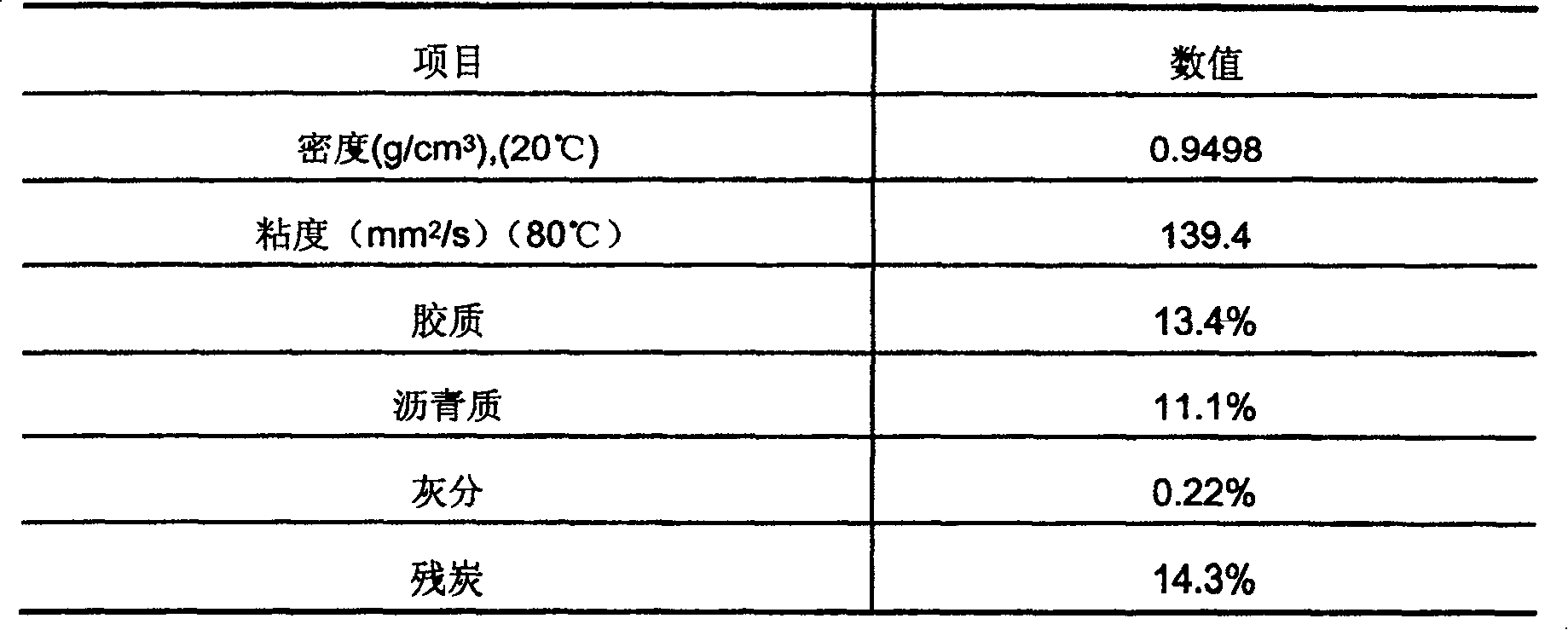Method for removing powder of catalyst in catalytic cracking oil slurry
A catalytic cracking oil slurry and catalyst technology, applied in the direction of electric/magnetic dehydration/emulsification, water treatment and refining, etc., can solve the problems affecting the treatment capacity and treatment cost, and achieve the goal of short removal time and high removal rate Effect
- Summary
- Abstract
- Description
- Claims
- Application Information
AI Technical Summary
Problems solved by technology
Method used
Image
Examples
Embodiment 1
[0021] The properties of the treated oil slurry A are shown in Table 1. The amount of flocculant added is 1000ppm, and the amount of demulsifier (FC9301) added is 100ppm. The specific method is as follows: add 0.8g of demulsifier (concentration: 2% by weight) to 15.2g of water, and mix it with 16g of flocculant (concentration: 1% by weight) to prepare After the solution is preheated to 95°C, mix it with 160g oil slurry preheated to 100°C, click and mix it 50 times with a juicer, pour it into a test tube, apply an electric field in the demulsifier, let it stand still to break the emulsion and separate the water. The electric field strength is 2000v / cm, take it out after 1 hour, pump out the lower layer of water, take the oil slurry and stir it evenly to measure the ash content. The test results are shown in Table 2. The removal effect of polyacrylamide is the best. The ash content of the oil slurry after removal is 0.01%, and the removal rate is 95.2%.
[0022] Table 1 Propert...
Embodiment 2
[0027] The properties of the treated oil slurry A are shown in Table 1. Adopt the method of thermal demulsification without electric field, polyacrylamide is selected as the flocculant, and the addition amount is 1000ppm, and the addition amount of demulsifier (FC9301) is 100ppm. The specific method is as follows: add 0.8g demulsifier (concentration: 2 wt.%) , and mixed with 16g flocculant (polyacrylamide, 1% concentration by weight) to form a solution, preheated to 95°C, mixed with 160g oil slurry preheated to 100°C, and clicked and mixed 50 times with a juice extractor, Put it in a pressure vessel and heat it to break the emulsion, take it out after 2 hours, pump out the water in the lower layer, take the oil slurry and stir it evenly to measure the ash content. The test results are shown in Table 3. Under the same temperature conditions, the effect of removing catalyst powder by thermal demulsification is worse than that of applying an electric field, and the removal rate a...
Embodiment 3
[0031] The properties of the treated oil slurry B are shown in Table 4. Use sucrose to increase the specific gravity of water, add 1000ppm of flocculant, and add 100ppm of demulsifier (FC9301), the specific method is as follows: get 6.4g sucrose and add 15.2g of water, add 0.8g demulsifier (concentration 2% by weight), and Mix 16g flocculant (concentration 1% by weight) to form a solution, preheat to 95°C, mix with 160g oil slurry preheated to 100°C, click and mix 50 times with a juicer, pour it into a test tube for demulsification Add an electric field to the instrument, stand still to break the emulsion and separate the water, the electric field strength is 2000v / cm, take it out after 1 hour, pump out the lower layer of water, take the oil slurry and stir it evenly to measure the ash content. The test results are shown in Table 5. It can be seen from the data in the table that polyacrylamide has the best effect, the removal rate reaches 87.4%, and the ash content of the oil ...
PUM
| Property | Measurement | Unit |
|---|---|---|
| boiling point | aaaaa | aaaaa |
| particle diameter | aaaaa | aaaaa |
Abstract
Description
Claims
Application Information
 Login to View More
Login to View More - R&D
- Intellectual Property
- Life Sciences
- Materials
- Tech Scout
- Unparalleled Data Quality
- Higher Quality Content
- 60% Fewer Hallucinations
Browse by: Latest US Patents, China's latest patents, Technical Efficacy Thesaurus, Application Domain, Technology Topic, Popular Technical Reports.
© 2025 PatSnap. All rights reserved.Legal|Privacy policy|Modern Slavery Act Transparency Statement|Sitemap|About US| Contact US: help@patsnap.com



